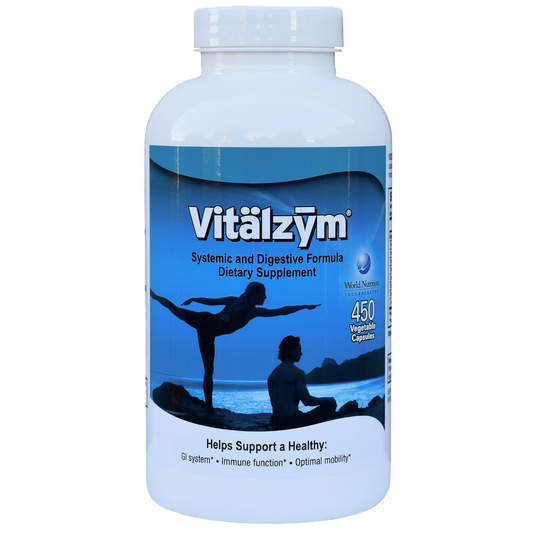Enzymes are the workhorses behind the scenes, driving the production of health supplements and natural products. But what happens to these vital catalysts once they have served their purpose? Can enzymes be reused? This article delves into enzyme recyclability and its significance in the health and wellness community. Uncover the advantages and challenges of reusing enzymes, and gain insights into how this practice aligns with sustainability principles. Join us on this journey of discovery as we explore the fascinating world of enzyme reuse.
The Importance of Enzyme Recyclability
Enzyme recyclability holds significant importance in the health and wellness industry, particularly in the production of natural and sustainable health solutions. By reusing enzymes, we can minimize waste and reduce the environmental impact associated with their production. This practice aligns with the principles of sustainability, as it promotes resource conservation and supports a more eco-friendly approach to manufacturing. Additionally, enzyme recyclability offers economic benefits by reducing production costs and increasing efficiency. Understanding the implications and limitations of enzyme reuse is crucial for individuals interested in the development and consumption of health supplements and natural products.
Can Enzymes Be Reused?
Yes, enzymes can be reused in certain circumstances. Enzyme recyclability refers to the practice of utilizing enzymes multiple times in various processes, such as the production of health supplements and natural products. This approach offers several advantages, including cost-effectiveness and reduced environmental impact. However, the ability to reuse enzymes depends on factors such as their stability, activity, and specific application. Proper handling, storage, and optimization of conditions are essential to maintaining enzyme functionality and maximizing their recyclability. By exploring the possibilities and limitations of enzyme reuse, we can harness their potential for sustainable and efficient production in the health and wellness industry.
How Can Enzymes Be Reused?
Enzyme Immobilization
Enzyme immobilization is a common method used to facilitate enzyme reuse. In this process, enzymes are attached or bound to a solid support or matrix, such as beads or membranes. This immobilization allows for easy separation of the enzyme from the reaction mixture, enabling its reuse in subsequent reactions. Immobilized enzymes can be used in various applications, including biocatalysis, where they exhibit enhanced stability and recyclability.
Enzyme Regeneration
Enzyme regeneration involves restoring the activity of used enzymes to their original state, allowing them to be reused. This can be achieved through various techniques, such as washing the enzyme to remove any inhibitors or byproducts that may have accumulated during the reaction. Additionally, optimizing reaction conditions, such as pH and temperature, can help maintain enzyme activity and prolong its usability.
Enzyme Cascade Reactions
Enzyme cascade reactions involve a series of sequential reactions, where the product of one reaction becomes the substrate for the next. By designing enzyme cascades, it is possible to reuse enzymes continuously, maximizing their efficiency and reducing the need for additional enzyme quantities. This approach is particularly useful in complex synthesis processes, where multiple enzymatic steps are required.
Enzyme Recovery and Purification
Efficient enzyme recovery and purification techniques are crucial for enabling their reuse. After a reaction, enzymes can be recovered through methods such as filtration, centrifugation, or chromatography. Purification steps may also be necessary to remove impurities or contaminants that could affect enzyme activity. By ensuring proper recovery and purification, enzymes can be effectively reused in subsequent reactions, minimizing waste and optimizing their performance.
Enzyme Engineering and Optimization
Enzyme engineering and optimization techniques can enhance enzyme recyclability. Through genetic modification or protein engineering, enzymes can be modified to improve their stability, activity, and resistance to degradation. This allows for more efficient reuse of enzymes over multiple cycles, extending their lifespan and enhancing their overall performance.

Do Enzymes Recycle Themselves?
Enzymes do not recycle themselves in the strict sense, as they are not capable of regenerating or repairing themselves. However, enzymes can be reused in various processes through proper handling and optimization. After a reaction, enzymes can be recovered, purified, and potentially regenerated to restore their activity and enable their reuse. Techniques such as enzyme immobilization, enzyme engineering, and optimization can enhance the recyclability of enzymes by improving their stability, activity, and resistance to degradation. By implementing these strategies, enzymes can be effectively reused, contributing to more sustainable and efficient production processes in the health and wellness industry.
What Is The Role Of Substrate, Biocatalysts, Reactivity, Metabolism and Proteins In Enzymes Recyclability
- Substrate: The substrate is the molecule or compound that undergoes a reaction catalyzed by an enzyme. The nature and properties of the substrate can influence the recyclability of enzymes. Compatibility between the substrate and the enzyme is crucial for efficient catalysis and subsequent reuse. Substrates that are easily accessible and compatible with the enzyme's active site can enhance enzyme recyclability.
- Biocatalysts: Enzymes act as biocatalysts, facilitating chemical reactions by lowering the activation energy required for the reaction to occur. The specific characteristics of enzymes, such as their catalytic efficiency and selectivity, play a vital role in their recyclability. Highly efficient enzymes can perform reactions rapidly, allowing for multiple cycles of reuse. Enzymes with high selectivity can ensure specific reactions occur without unwanted side reactions, enhancing their recyclability.
- Reactivity: The reactivity of enzymes refers to their ability to undergo reactions and maintain their catalytic activity. Enzymes with high reactivity are more likely to be recyclable as they can sustain their activity over multiple reaction cycles. Factors such as enzyme stability, resistance to denaturation, and resistance to degradation by reaction byproducts or environmental conditions can influence their reactivity and recyclability.
- Metabolism: Enzymes are involved in various metabolic pathways within living organisms. The metabolic processes in which enzymes participate can impact their recyclability. Enzymes involved in essential metabolic pathways may have evolved to be highly recyclable to ensure the efficient utilization of resources. Understanding the metabolic context of enzymes can provide insights into their potential for recyclability and their role in sustaining biological processes.
- Proteins: Enzymes are specialized proteins that act as biocatalysts. The protein structure of enzymes plays a crucial role in their recyclability. Proper folding and conformation of the enzyme's protein structure are essential for maintaining its catalytic activity and stability. Proteins that are more resistant to denaturation and degradation are more likely to be recyclable. Additionally, protein engineering techniques can be employed to optimize the protein structure of enzymes, enhancing their recyclability and overall performance.
What Are The Challenges Of Enzymes Recyclability?
Enzyme recyclability, while promising, is not without its challenges. Several factors can pose obstacles to the effective reuse of enzymes. One significant challenge is enzyme stability. Enzymes can be sensitive to various environmental conditions, such as temperature, pH, and the presence of inhibitors or denaturing agents.
Over time, enzymes may lose their activity or become deactivated, limiting their recyclability. Another challenge is the potential for enzyme degradation. Enzymes can be susceptible to degradation by reaction byproducts or proteases present in the reaction mixture. This degradation can lead to a decline in enzyme activity and hinder their ability to be reused. Additionally, enzyme specificity can be a challenge.
Some enzymes may have a narrow substrate range or exhibit selectivity towards specific reaction conditions, making them less versatile for reuse in different processes. Finally, the cost associated with enzyme recovery, purification, and regeneration can be a practical challenge. These processes require additional resources and may impact the overall economic feasibility of enzyme recyclability.
Overcoming these challenges requires a combination of strategies, such as optimizing reaction conditions, improving enzyme stability, developing robust immobilization techniques, and exploring enzyme engineering approaches. By addressing these challenges, we can enhance the recyclability of enzymes and unlock their full potential for sustainable and efficient production processes in various industries.
Conclusion
In conclusion, the recyclability of enzymes holds great potential in the production of health supplements and natural products. By reusing enzymes, we can minimize waste, reduce production costs, and contribute to a more sustainable and environmentally friendly approach. However, challenges such as enzyme stability, degradation, specificity, and associated costs must be addressed to fully harness the benefits of enzyme recyclability. Through advancements in enzyme engineering, optimization of reaction conditions, and the development of robust recovery and purification techniques, we can overcome these challenges and pave the way for a future where enzymes are efficiently reused in the health and wellness industry. Embracing enzyme recyclability not only aligns with the principles of sustainability but also opens doors to innovative and eco-friendly solutions that benefit both individuals and the planet.
Final Thoughts
Discover a new level of energy and vitality with Vitalzym Extra Strength, the groundbreaking enzyme supplement from World Nutrition. Formulated with the potent enzyme papain sourced from papaya, this exceptional product elevates enzyme levels, strengthens the immune system, and promotes optimal circulation. Featuring key ingredients like serrapeptase and bromelain, Vitalzym revitalizes your well-being, helping you live a healthier and more vibrant life. Experience the transformative effects of Vitalzym for yourself today!*
Sources
- https://www.youtube.com/watch?v=sL_iEOuvK80
- https://isntsciencewonderful.wordpress.com/2016/01/17/effects-of-temperature-and-ph-on-enzymes/
- https://www.youtube.com/watch?v=q0EY7CEkoYQ
- https://nanotempertech.com/blog/3-ways-to-know-your-protein-purification-is-a-success/
- https://medium.com/advances-in-biological-science/exemplary-success-story-in-computational-enzyme-engineering-915924122136
These statements have not been evaluated by the food and drug administration (FDA). These products are not intended to diagnose, treat, cure, or prevent any disease.







